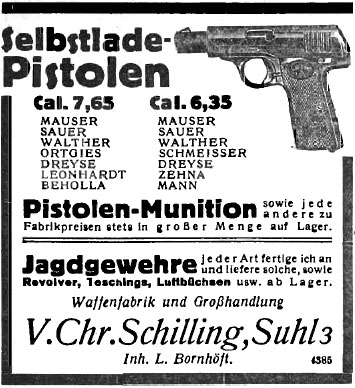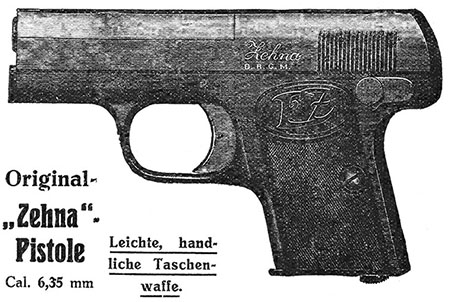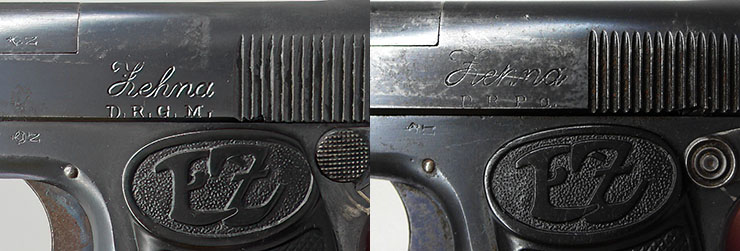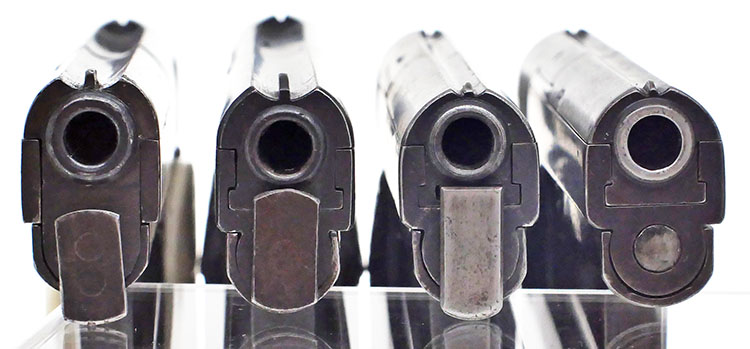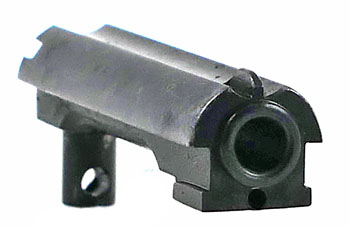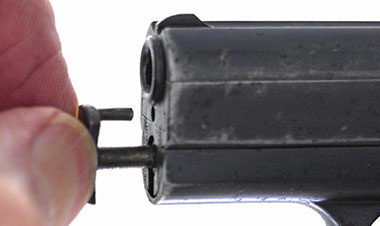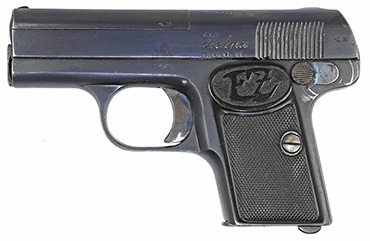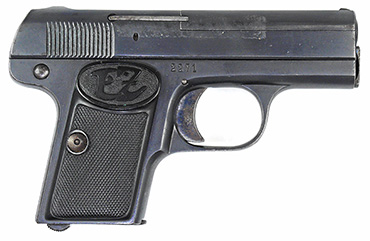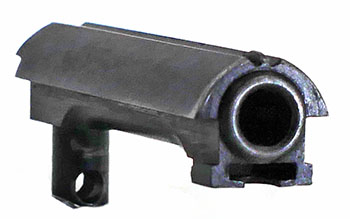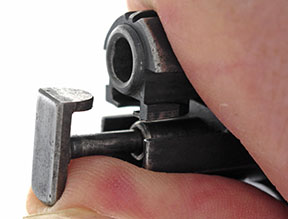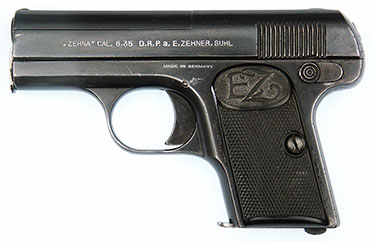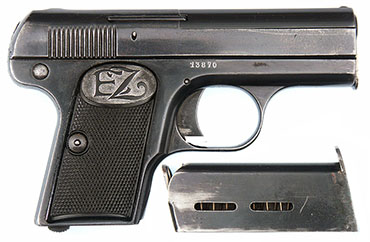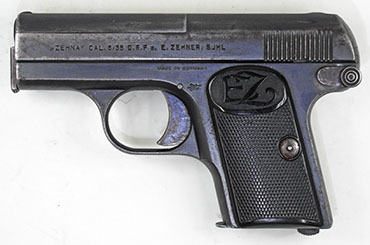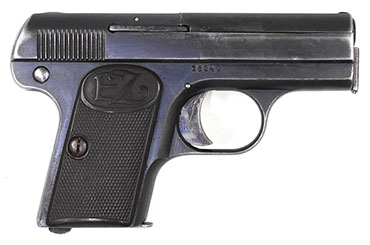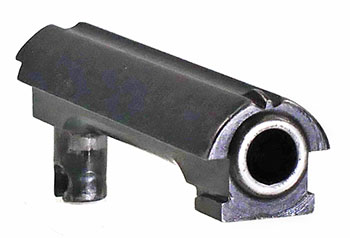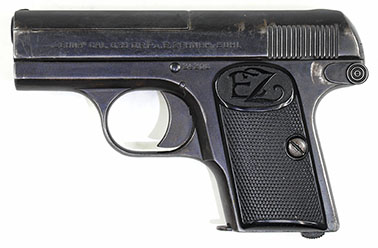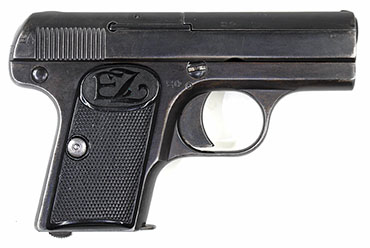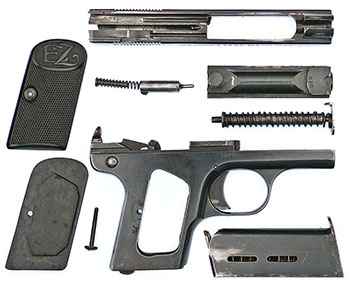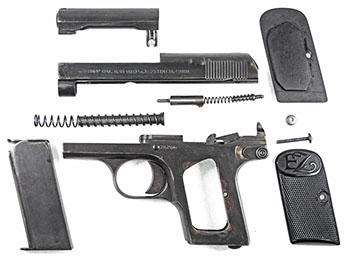 |
||||||||||||||||||||||||||||||||||||||||||||||||||||||||||||||||||||||||||||||||||||||||||||||||||||||||||||||||||||||||||||||||||||||||||||||||||||||||||||||||||||||||||||||||||||||||||||||||||||||||||||||||||||||||||||||||||||||||||||||||||||||||||||||||||||||||||||||
|
The Zehna Pistol by Ed Buffaloe
The prototype Zehna pistol, as shown in the patent, was probably redesigned to speed up production and to reduce manufacturing costs which is the usual reason for minor changes like we see in this gun. The earliest production Zehna pistols (I have documented examples from serial number 71 through 2805) were marked “D.R.G.M.” which means that a Gebrauchsmuster, or utility model, had been issued for the design. The Gebrauchsmuster was a form of limited (three year) patent protection that required registration of the design but not examination of it. Waffenschmied reported, in its 25 November 1919 issue, that Emil Zehner had been granted a Gebrauchsmuster for a “barrel fixation method for self-loading pistols.” It seems to me that, with his design registered at the patent office through a Gebrauchsmuster and a patent application filed, he could have begun commercial production as early as December of 1919.
Interestingly, the very last Zehna pistol I have documented, serial number 27030, still bears the D.R.P.a. stamp. This indicates to me the possibility that all known Zehna pistols were made prior to the granting of the patent on 13 July 1923; it seems reasonable that, as soon as the patent was granted, Emil Zehner would have switched the inscription to D.R.P., Deutsches Reichs Patent, to indicate the design was fully protected. On the other hand, since the design changed three times after the patent was filed, and the claims of the patent were relatively limited, perhaps Zehner felt he should simply stick with “patent applied for,” since the patent did not cover the exact design he was manufacturing.
The first variant Zehna pistol is characterized by a 2.5 inch barrel with short rails at the front that fit into cuts in the slide, and there is a hole just beneath the barrel opening for the pin on the end-plate of the recoil spring guide rod. The end plate has cuts on either side to allow it to be grasped with fingernails.
On the left side, just in front of the serrations, is the inscription: Zehna Somewhere between serial number 2271 and 4072, the inscription was changed, as follows: Zehna The finish is rust blue with the trigger, safety, end plate on the recoil guide rod, and the grip screw and nut being fire blued. Grip plates are of checkered hard rubber with the EZ monogram in an oval at the top. The magazine has two slots for viewing cartridges on the right side only. The last few hundred first variant guns received new grip plates and a new slide inscription. The only difference in the grip plates was a redesigned EZ monogram with a more elegant look. The new slide inscription was on a single line, in all-capital sans-serif characters, as follows: „ZEHNA‟ CAL. 6,35 D.R.P.a. E. ZEHNER, SUHL The last serial number I have identified, as a first variant, is 9961. Please write to me if you have a later first variant Zehna.* Hogg states that the quality of the early guns was not as good as the later variants. All I can say for certain is that not many of the early guns remain in pristine condition. I have not noted any first variant guns that are marked for export. At this time, I estimate that approximately 10,000 first variant guns were made.
I have noted several first variant Zehna pistols with the long pin on back of the front plate broken off, so I suspect that Emil Zehner decided it was necessary to redesign the front plate to be a little more robust. This required a slight redesign of the barrel. Later, he made other changes to the second variant. The redesign of the front plate and barrel took place at about serial number 10000. Please write to me if you have a serial number between 9900 and 10100 and send photographs of your gun.*
By serial number 14615, the barrel is shortened to 2.37 inches. The top of the slide is machined differently; the sighting groove is narrower by about 4mm and the front sight is not as tall. The overall weight is reduced by about 23 grams. The position of the extractor is moved down on the right side so it lies even with the bottom of the right barrel flange, and the pin that holds the extractor now runs through the slide vertically, rather than at an angle, as on the earlier guns. The slide serrations are moved a little further to the rear. Finally, an indicator that the striker is cocked is added; the recoil spring guide rod now has a pin on the end which extends through a hole in the striker spring backstop when the striker is cocked.
The highest serial number I have recorded for a second variant Zehna is 22382. At this time, I estimate that approximately 12,350 second variant Zehna pistols were made. Please write to me if you have a late second variant Zehna.*
The Third Variant Zehna The third variant Zehna pistol has its method of barrel retention redesigned again. The long pin through the center of the recoil spring guide rod is eliminated in favor of a transverse pin through the frame. The serial number is moved to the left side of the frame. There continue to be 15 slide serrations. The barrel on my third variant measures 2.355 inches, slightly shorter (by .015 inch) than my second variant gun. The third variant Zehna retains all other features and markings of the late second variant. I have not documented a third variant pistol that was marked for export.
I have recorded serial numbers for third variant Zehna pistols between 22899 and 27030. I estimate that only about 4250 third variant guns were made. I am still collecting serial numbers of third variant guns so please write to me, especially if you have a very early or very late specimen.*
Field Stripping the Third Variant
* Write to edbuffaloe@unblinkingeye.com. |
||||||||||||||||||||||||||||||||||||||||||||||||||||||||||||||||||||||||||||||||||||||||||||||||||||||||||||||||||||||||||||||||||||||||||||||||||||||||||||||||||||||||||||||||||||||||||||||||||||||||||||||||||||||||||||||||||||||||||||||||||||||||||||||||||||||||||||||
|
Copyright 2008-2022 by Ed Buffaloe. All rights reserved. |
||||||||||||||||||||||||||||||||||||||||||||||||||||||||||||||||||||||||||||||||||||||||||||||||||||||||||||||||||||||||||||||||||||||||||||||||||||||||||||||||||||||||||||||||||||||||||||||||||||||||||||||||||||||||||||||||||||||||||||||||||||||||||||||||||||||||||||||
|
||||||||||||||||||||||||||||||||||||||||||||||||||||||||||||||||||||||||||||||||||||||||||||||||||||||||||||||||||||||||||||||||||||||||||||||||||||||||||||||||||||||||||||||||||||||||||||||||||||||||||||||||||||||||||||||||||||||||||||||||||||||||||||||||||||||||||||||
|
|
||||||||||||||||||||||||||||||||||||||||||||||||||||||||||||||||||||||||||||||||||||||||||||||||||||||||||||||||||||||||||||||||||||||||||||||||||||||||||||||||||||||||||||||||||||||||||||||||||||||||||||||||||||||||||||||||||||||||||||||||||||||||||||||||||||||||||||||
